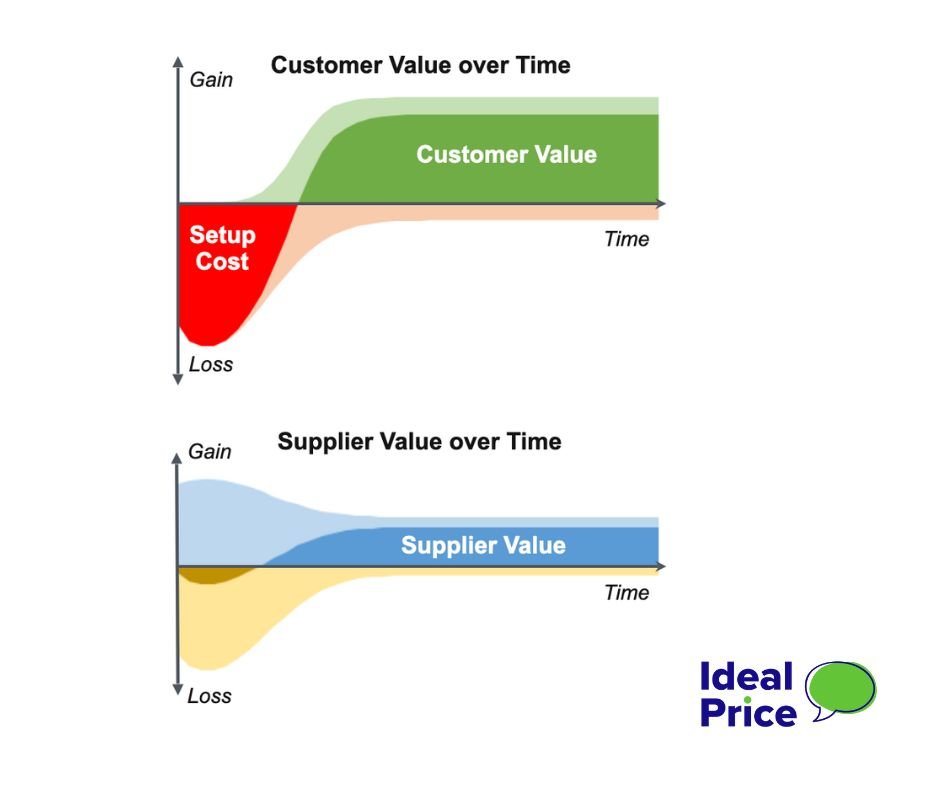Designing your Ideal Pricing Model
Subscription pricing. Pay-per-use, performance-based pricing, value pricing. There’s lots of talk about all these topics, but much less on if, when, and how to use them for B2B pricing. In our experience with almost 100 startup and scale-up clients, teams often get stuck figuring how to evaluate the different options.
Getting this right will help your business grow faster, sustainably, and more profitably: just what you and your investors are looking for! First up, many of these terms are used loosely. Let’s define a few terms:
Price models are the full set of prices and policies that define how much the customer will pay.
Price carriers are building blocks of price models. These are the things that “carry” the price, such as the price-per-unit, the number of users (software), or the usage of the service. They can also include price policies like surcharges the customer must pay, or penalties on the supplier that reduce the price if certain conditions are not met.
Focusing on the core price carriers that are used to set a price, we can group them into 4 buckets:
Up-front pricing: these are “one-and-done” payments for products or services. Think buying a lightbulb, one-time equipment service, or “perpetual license” software.
Subscription pricing: these are a set of fixed payments (say every month) for the use of the product or service during the subscription term. Set up front, they are a fixed amount per period. Examples include magazine subscriptions, vehicle rental, or a SaaS subscription.
Pay-per-use: also known as usage-based pricing or pay-as-you-go. Here payments are based on how much the service (or product) you use in a period. Electricity consumption, rental car excess mileage fees, and even printer ink are common examples. Pay-per use is very common for services: consultants, lawyers, agencies, etc. often charge this way.
Outcome pricing: this is yet another type of pricing based on the result of the product or service delivered. The customer price is set by the improvement in some pre-defined metric agreed in advance with the customer. Extreme examples include “no win, no fee” legal services, and also includes bonus payments for meeting performance goals (e.g. distributors meeting sales targets). They can also include penalties, e.g. surcharges for missing commitments. The purest form of value-based pricing is a subset of outcome pricing, where the price paid is driven by the value that the customer captures.
Each of these pricing carrier types has its benefits and drawbacks. The following table outlines key factors that will help you figure out which ones are more appropriate for your business:
Most B2B solutions and offers benefit from using more than just one of these types of price carriers. As always, a trade-off will have to be made between pricing sophistication and complexity.
Also note that in the real world, some pricing approaches are a hybrid between some of these ‘pure’ tactics. Nothing wrong with that - just review the different pros and cons with the appropriate lens.
What are the steps to follow to use these insights? We use the following ABCD approach iteratively with our clients:
A) Ambition: make sure you understand what you are trying to achieve in your business, the resources and constraints that will drive your activities, your risks’ tolerance, and timelines.
B) Blueprint of pricing: start by understanding which customers you are targeting (the customer segments), what are you selling (the offer structure), and what is their Next Best Alternative to your solution. With this in mind, understand the full value (and barriers to value) that your solution brings to the key buying stakeholders. Then, brainstorm on the possible price carriers for each of these groupings, and assess which ones will help you fulfill your different goals. Finally, it’s time to build your pricing blueprint(s) and set the proposed price levels for each price carrier and pricing models for important customer segments.
C) Check: validating the hypotheses and assumptions that drove your pricing design, particularly the value drivers, price model, and price levels. This includes modeling, researching, asking customers, and reviewing Next Best Alternative (e.g. competitor) pricing.
D) Deploy: putting together all the pieces to bring it to life, including price & value communication, channel, and sales incentives, etc.
Taking a structured, fact-based approach to designing your pricing model and incorporating the right price carriers, can make all the difference to the financial success of your solution.
Key Take-aways
Different price carriers will help you to build a B2B pricing model that works for you and your customers.
Each of the four different types of price carriers (upfront, subscription, pay-per-use, and outcome) has its own set of pros and cons based on your and your customer’s approach to value, risk perception and tolerance, and time-to-value
Taking a structured approach and validating the key assumptions, will allow you to build your Ideal Price Model quickly, and help your business grow fast
Unsure which pricing model fits better your company, contact us here and we will help you to develop Ideal Pricing approach.
Join our Free Webinar on January 26, 14.30 CET time zone. Topic: Designing your Ideal Pricing Model: when to use subscription, pay-per-use and other approaches. Speaker Dr.Ian Tidswell. You can register through LinkeDin here or send us request through contact here form with the text “Interested in Webinar”


